-

新人教版高中英语选修2Unit 4 Learning about Language教学设计
This section guides students to pay attention to the typical context of vocabulary use, helps students accumulate vocabulary around the key vocabulary of this unit, and uses the learned words and word chunks in different contexts to deeply understand their meaning and usage, so as to achieve the purpose of review and consolidation.The teaching design activities aim to guide students to pay attention to the typical context in which the target vocabulary is used, as well as the common vocabulary used in collocation, so that students can complete the sentence with correct words. In terms of vocabulary learning strategies, this unit focuses on cultivating students' ability to pay attention to collocation of words and to use word blocks to express meaning.For vocabulary learning, it is not enough just to know the meaning of a single word, but the most important thing is to master the common collocations of words, namely word blocks.Teachers should timely guide students to summarize common vocabulary collocation, such as verb and noun collocation, verb and preposition collocation, preposition and noun collocation, and so on.1. Guide students to understand and consolidate the meaning and usage of the vocabulary in the context, 2. Guide the students to use the unit topic vocabulary in a richer context3. Let the students sort out and accumulate the accumulated vocabulary, establishes the semantic connection between the vocabulary,4. Enable students to understand and master the vocabulary more effectivelyGuiding the Ss to use unit topic words and the sentence patterns in a richer context.

新人教版高中英语选修2Unit 4 Reading for writing教学设计
假定你是英国的Jack,打算来中国旅行,请你给你的中国笔友李华写一封信,要点如下:1.你的旅行计划:北京→泰山→杭州;2.征求建议并询问他是否愿意充当你的导游。注意:1.词数80左右(开头和结尾已给出,不计入总词数);2.可以适当增加细节,以使行文连贯。参考词汇:故宫 the Forbidden City;泰山 Mount TaiDear Li Hua,I'm glad to tell you that 'm going to visit China.First,I am planning to visit Beijing,the capitalof China,where I am looking forward to enjoying the Great Wall,the Forbidden City and somebeautiful parks.Then I intend to go to visit Mount Tai in Shandong Province.I've heard that it is one ofthe most famous mountains in China and I can't wait to enjoy the amazing sunrise there.After that,I amalso going to Hangzhou.It is said that it is a beautiful modern city with breathtaking natural sights,among which the West Lake is a well- known tourist attraction.What do you think of my travel plan? Will you act as my guide? Hope to hear from you soon.

新人教版高中英语选修2Unit 4 Using langauge-Listening教学设计
The theme of the listening section is " talking about scenery and culture along a journey."The part is designed to further lead the students to understand Canadian natural geography and social environment, and integrated into the cultural contrast by mentioning the long train journey from Beijing to Moscow routes. On this basis, the part activates students related travel experience, lets the student serial dialogue, guides the student to explore further the pleasure and meaning of the long journey, and Chinese and foreign cultural comparison.The part also provides a framework for the continuation of the dialogue, which is designed to provide a framework for students to successfully complete their oral expressions, and to incorporate an important trading strategy to end the dialogue naturally.1. Help students to understand and master some common English idioms in the context, and experience the expression effect of English idioms.2. Guide the students to understand the identity of different people in the listening context, and finish the dialogue according to their own experience.3. Instruct the students to use appropriate language to express surprise and curiosity about space and place in the dialogue, and master the oral strategy of ending the dialogue naturally.1. Instruct students to grasp the key information and important details of the dialogue.2. Instruct students to conduct a similar talk on the relevant topic.

新人教版高中英语选修2Unit 5 Learning about Language教学设计
The purpose of this section of vocabulary exercises is to consolidate the key words in the first part of the reading text, let the students write the words according to the English definition, and focus on the detection of the meaning and spelling of the new words. The teaching design includes use English definition to explain words, which is conducive to improving students' interest in vocabulary learning, cultivating their sense of English language and thinking in English, and making students willing to use this method to better grasp the meaning of words, expand their vocabulary, and improve their ability of vocabulary application. Besides, the design offers more context including sentences and short passage for students to practice words flexibly.1. Guide students to understand and consolidate the meaning and usage of the vocabulary in the context, 2. Guide the students to use the unit topic vocabulary in a richer context3. Let the students sort out and accumulate the accumulated vocabulary, establishes the semantic connection between the vocabulary,4. Enable students to understand and master the vocabulary more effectivelyGuiding the Ss to use unit topic words and the sentence patterns in a richer context.Step1: Read the passage about chemical burns and fill in the blanks with the correct forms of the words in the box.

新人教版高中英语选修2Unit 5 Reading and thinking教学设计
The theme of this activity is to learn the first aid knowledge of burns. Burns is common in life, but there are some misunderstandings in manual treatment. This activity provides students with correct first aid methods, so as not to take them for granted in an emergency. This section guides students to analyze the causes of scald and help students avoid such things. From the perspective of text structure and collaborative features, the text is expository. Expository, with explanation as the main way of expression, transmits knowledge and information to readers by analyzing concepts and elaborating examples. This text arranges the information in logical order, clearly presents three parts of the content through the subtitle, accurately describes the causes, types, characteristics and first aid measures of burns, and some paragraphs use topic sentences to summarize the main idea, and the level is very clear.1. Guide students to understand the causes, types, characteristics and first aid methods of burns, through reading2. Enhance students’ ability to deal withburnss and their awareness of burns prevention3. Enable students to improve the ability to judge the types of texts accurately and to master the characteristics and writing techniques of expository texts.Guide students to understand the causes, types, characteristics and first aid methods of burns, through readingStep1: Lead in by discussing the related topic:1. What first-aid techniques do you know of ?CPR; mouth to mouth artificial respiration; the Heimlich Manoeuvre

新人教版高中英语选修2Unit 5 Using langauge-Listening教学设计
The theme of this section is to learn how to make emergency calls. Students should learn how to make emergency calls not only in China, but also in foreign countries in English, so that they can be prepared for future situations outside the home.The emergency telephone number is a vital hotline, which should be the most clear, rapid and effective communication with the acute operator.This section helps students to understand the emergency calls in some countries and the precautions for making emergency calls. Through the study of this section, students can accumulate common expressions and sentence patterns in this context. 1.Help students accumulate emergency telephone numbers in different countries and learn more about first aid2.Guide the students to understand the contents and instructions of the telephone, grasp the characteristics of the emergency telephone and the requirements of the emergency telephone.3.Guide students to understand the first aid instructions of the operators.4.Enable Ss to make simulated emergency calls with their partners in the language they have learned1. Instruct students to grasp the key information and important details of the dialogue.2. Instruct students to conduct a similar talk on the relevant topic.Step1:Look and discuss:Match the pictures below to the medical emergencies, and then discuss the questions in groups.
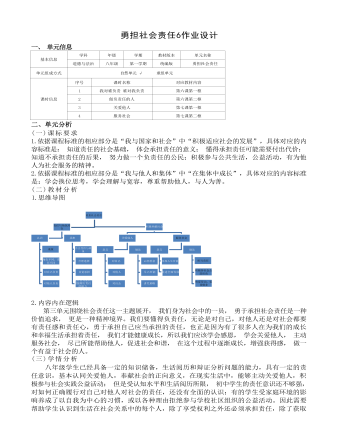
道德与法治八年级上册勇担社会责任6作业设计
8.“在前进的道路上, 我们搬开别人脚下的绊脚石有时恰恰是为自己铺路。”这告诉我们( )A.真诚的关爱都是为了补偿 B.关爱自己也就是关爱了他人C.关爱他人,也是关爱和善待自己 D.关爱他人不能获得任何帮助9.2021 年 5 月 10 日人民日报报道:陕西西安一饺子馆老板李恺一年多来坚持为困难人群提供 爱心餐,求助者只需报暗号“A 套餐”即可免费领取。李恺的行为( )A.自觉履行了法定义务 B.关爱了他人并且能讲究策略 C.是为了赢得他人赞许 D.体现服务社会需要爱岗敬业 10.全国“新时代好少年”小李长期积极参加首都博物馆、首都图书馆义务讲解, 以及社区绿 色低碳宣传活动, 组织同学为边远地区贫困小学捐赠衣物和书籍,帮助非洲儿童接种疫苗。 这启示我们要( )A.遵守制度,维护规则 B. 积极实践,服务社会C.走出国门,展示风采 D.努力学习,体味生活11.近年来, 感动中国人物已成为人民广泛学习的楷模。为了更好地传递这些人物身上的正能 量,我们要( )①热心公益,服务社会 ②积极承担责任,不言代价与回报③培养高度的社会责任感 ④从身边小事做起,只对自己负责
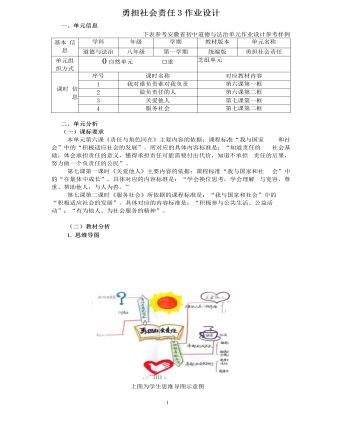
道德与法治八年级上册勇担社会责任3作业设计
一、单项选择题1、 以下是某校807班学生小丽的生活片段,下列行为中属于积极承担责任的是()A. 上学迟到,怪妈妈没及时叫醒自己B. 考试没考好,怨试题太难C. 保持本班卫生整洁,在别的班级卫生区随手乱扔垃圾D. 打扫卫生时不小心将教室玻璃打碎,如实告诉老师2、 某校807班学生小丽在上学路上遇到了很多人,这些人扮演的角色与其应承担的责任不对应的是( )A. 执勤的交警:维护秩序B.上学的学生:孝敬父母C.早到的老师:教书育人 D.跑步的阿姨:遵守规则3、 在家庭生活中,我们是父母的孩子,在学校里,我们是老师的学生,在社会上,我们是国 家的公民,这说明()A. 人是善变的B. 每个人扮演着不同的角色C. 人善于适应新环境D. 每个人都想不断改变自己4、某校807班的学生对于中学生参与社会公益活动,有着不同的看法,下列同学的看法中正 确的是( )A. 甲同学:中学生学习任务重,参与社会公益活动只会影响学习B. 乙同学:中学生年龄小,社会经验不足,不具有参与社会公益活动的能力
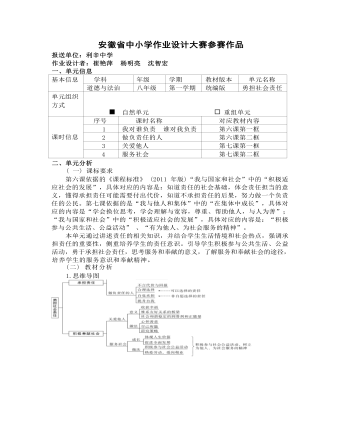
道德与法治八年级上册勇担社会责任11作业设计
二、单元分析( 一) 课标要求第六课依据的《课程标准》 (2011 年版)“我与国家和社会”中的“积极适 应社会的发展”,具体对应的内容是:知道责任的社会基础,体会责任担当的意 义,懂得承担责任可能需要付出代价,知道不承担责任的后果,努力做一个负责 任的公民。第七课依据的是“我与他人和集体”中的“在集体中成长”,具体对 应的内容是“学会换位思考,学会理解与宽容,尊重、帮助他人,与人为善”; “我与国家和社会”中的“积极适应社会的发展”,具体对应的内容是:“积极 参与公共生活、公益活动” 、“有为他人、为社会服务的精神”。本单元通过讲述责任的相关知识,并结合学生生活情境和社会热点,强调承 担责任的重要性,侧重培养学生的责任意识。引导学生积极参与公共生活、公益 活动,勇于承担社会责任,思考服务和奉献的意义,了解服务和奉献社会的途径, 培养学生的服务意识和奉献精神。
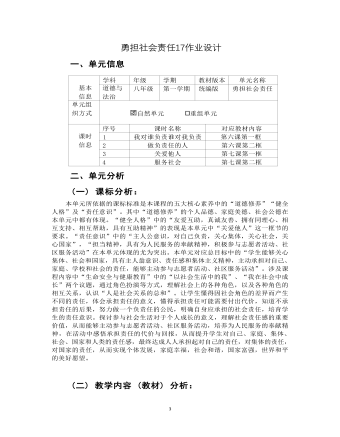
道德与法治八年级上册勇担社会责任17作业设计
答案解析:(1) 共同说明服务和奉献社会,需要我们青年担当责任的道理。(2) 服务和奉献社会,需要我们树立远大理想,努力学习,热爱劳动,培 养敬业精神,学会全力以赴、精益求精、追求卓越,为将来成为合格的社会主义 建设者做好准备;服务和奉献社会需要我们积极参与各种形式的社会公益活动; 服务和奉献社会还需要我们关心国家的发展,自觉投身社会实践,积极为祖国的 发展建言献策,努力肩负起实现中华民族伟大复兴的历史使命等。3、作业 3、作业分析:本题考查作业目标中“知道中学生奉献社会的途径,积极参与社 会活动,增强社会责任感”,创设情境取材于我县文明城市创建,创建中我县高 度重视,广大市民积极参与,学生自己、他们的父母及所在的社区都参与了创建, 学生对这一活动有一定的认知,也有参与的热情。但是,让学生自己组织一次志 愿活动还是有相当难度的。
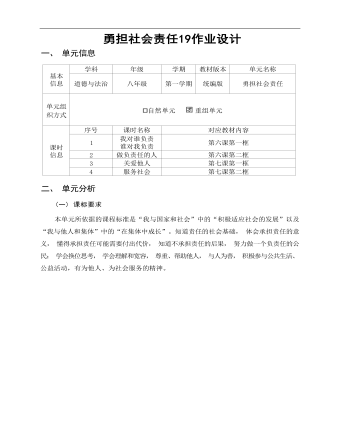
道德与法治八年级上册勇担社会责任19作业设计
【做一位负责任的公民】各小组同学积极参与了上述问题的讨论, 并就如何做一位负责任的公民, 赢得社会对自 己的赞成票达成了一致建议。(4)请你写出该建议的内容。 答案:(1)陪伴孤寡老人、打扫卫生等。(2) 为灾区捐款; 义务植树; 回收废旧电池; 开展法律宣传; 帮助孤寡老人; 清除街头 小广告等。(3) 参加志愿者活动是主动承担社会责任的体现, 有利于锻炼自己的实践能力, 提升思 想道德素质, 促进自己的健康成长; 有利于赢得社会对自己的赞成票; 有利于良好社会 风气的形成,促进社会文明进步。(4) 认清责任, 树立起强烈的责任意识; 从我做起, 从现在做起, 从点滴小事做起, 养 成负责任的习惯; 学会在不同责任面前进行选择, 科学地安排时间, 学会统筹兼顾, 履 行好自己的职责; 自觉守法, 维护社会秩序; 服务社会, 奉献社会; 服务和建设自己所 在的社区;积极参与社会公益活动等。
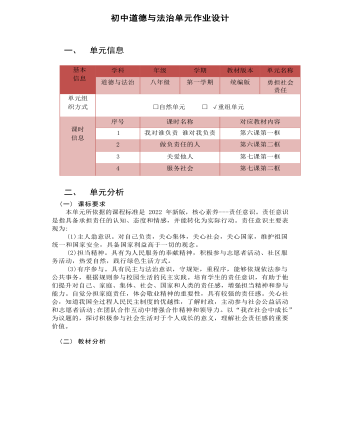
道德与法治八年级上册勇担社会责任1作业设计
2. “对不起,我和同学不小心把您的车划了一道,这是我的电话号码,看 到后请与我联系。”2020 年 7 月 22 日,湖北卫辉市两名中学生不小心刮蹭了他 人汽车,主动给车主纸条留言。这一举动启示我们( )A.生活中一定不能犯错 B.要学会抵制不良诱惑C.行为不同,后果相同 D.对自己的行为后果负责3.爱因斯坦说:“我的精神生活和物质生活都依靠着别人的劳动,我必须尽 力以同样的分量来报偿我所领受了的和至今还在领受着的东西。 ”这启示我们 ( )①要学会感恩,主动帮助他人和服务社会②回报社会应当以别人对我们负责为前提③努力创造物质和精神财富是负责任的表现④关心他人、服务社会要坚持等量交换跟则A.①② B.①③ C.②④ D.③④ 4.疫情来袭,我们需要守望相助。面对“大考” ,我们需要共同守“沪”。安徽省援沪医疗队 1030 名核酸采样队员在上海连续奋战 36 天后,圆满完成援沪 抗疫任务启程返皖。这些“逆行者”的可敬之处在于 ( )①爱岗敬业,平凡中创造伟大②争先恐后,追求个人荣誉③勇担责任,不言代价与回报
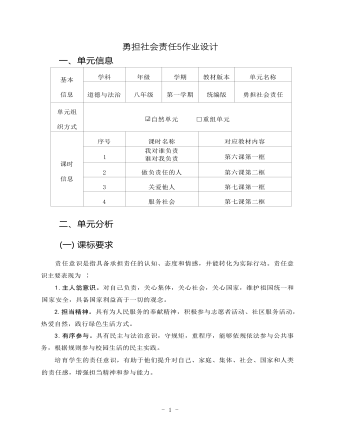
道德与法治八年级上册勇担社会责任5作业设计
(一) 课标要求责任意识是指具备承担责任的认知、态度和情感,并能转化为实际行动。责任意 识主要表现为 ∶1.主人翁意识。对自己负责,关心集体,关心社会,关心国家,维护祖国统一和 国家安全,具备国家利益高于一切的观念。2.担当精神。具有为人民服务的奉献精神,积极参与志愿者活动、社区服务活动, 热爱自然,践行绿色生活方式。3.有序参与。具有民主与法治意识,守规矩,重程序,能够依规依法参与公共事务,根据规则参与校园生活的民主实践。培育学生的责任意识,有助于他们提升对自己、家庭、集体、社会、国家和人类 的责任感,增强担当精神和参与能力。学生能够关心集体、社会和国家,具有主人翁意识、责任感和集体主义精神,主 动承担对自己、家庭、学校和社会的责任, 自觉维护祖国统一和国家安全;能够主动 参与志愿者活动、社区服务活动,具有为人民服务的奉献精神,勇于担当;能够遵守 社会规则和社会公德,依法依规有序参与公共事务,具有公共意识和公共精神;敬畏 自然,保护环境,形成人与自然生命共同体意识。
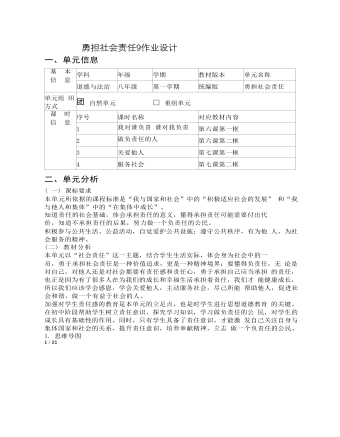
道德与法治八年级上册勇担社会责任9作业设计
解析:C 此题考查服务社会,考查学生分析理解能力。解答此题需要结合所学,准确作答。 根据所学,分析题干关键词“志愿服务、献爱心”等可知,李晓和好友积极参与社会公益活动,服务社会、奉献社会,能营造良好的社会氛围, 也是做负责任公民的重要表现,①②④正确;从事志愿活动一方面承担更多的责 任,但往往也得到回报,如获得他人的肯定,③错误。故选 C。(核心素养:家国情怀 责任担当)10.古人云: “大事难事看担当,逆境顺境看襟度。 ”对于应负的责任,迎着风 险也要干好,不论回报,实践担当的精神,提升担当的能力,做到敢担当,能担 当,会担当,善担当。这启示我们 ( )①要义无反顾地担当应负的责任②履行社会责任要先看代价与回报③要提升自身素质,增强履行责任的能力④要将每一项社会责任都当作自己不可推卸的责任A. ①② B. ①③ C. ②④ D. ③④解析:B 此题考查自觉承担责任的要求,考查对材料的分析理解能力。解答本 题的关键是审清题意,据题意排除错误选项和干扰选项。积极承担责任是做人的基本要求,题干信息启示我们要积极承担责任。
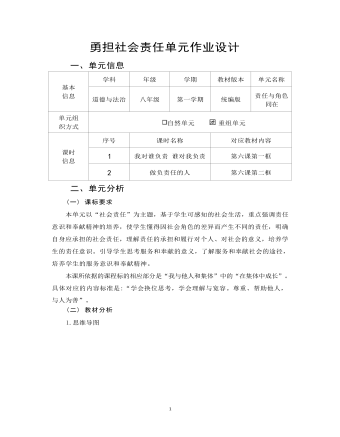
道德与法治八年级上册勇担社会责任7作业设计
一、单项选择题1.C 2.C 3.B二、非选择题4. 如:忠诚人民,勇敢无畏; 防疫攻坚, 白衣战士奋勇争先; 勇敢是你们的担当,奉献是你们的品质。5. (1) ①服务社会体现人生价值,才能得到人们的尊重和认可,实现我们 自身的价值;②服务社会能够促进我们全面发展,在服务社会的过程中,我们的 视野不断拓展,知识不断丰富,分析、解决问题的能力以及人际交往能力不断提 升,道德境界不断提高。(2) 本题属于开放性问题,列举的活动符合题意,言之有理即可。(3) ①努力学习科学文化知识,树立崇高而远大的理想,立志成才;②积 极参加社会实践活动,全面提高自身的素质;③积极承担社会责任,树立服务社 会、奉献社会的意识;④把个人前途和祖国命运紧密联系在一起,增强民族自信, 做自信中国人。从其他角度作答,符合题意,言之有理即可。
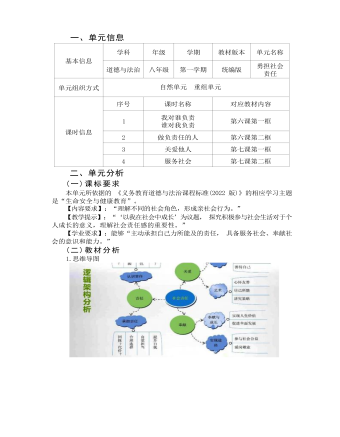
道德与法治八年级上册勇担社会责任8作业设计
2.内容内在逻辑本单元是八年级上册教材的第三单元,在逻辑结构上起着承上启下的作 用。在了解社会生活和社会规则的基础上,本单元将进一步引导学生明确社会责 任,积极主动服务奉献社会,所以本单元是对第一单元、第二单元内容的深化。 第四单元“维护国家利益”“担当历史使命”则进一步将社会责任扩展到国家层 面,是对本单元内容的进一步拓展。本单元以“社会责任”为主题,从学生发展需要和当前学生思想状况出 发,基于学生对责任、奉献等的理解和可感知的社会生活,帮助学生理解因社会 角色的差异而产生不同的责任,懂得对自己的行为负责,帮助学生理解承担责任 可能会获得回报,也可能只付出一定的代价,使学生理性对待承担责任过程中的 得与失。明确自身应承担的社会责任,理解责任的承担和履行对个人、对社会的 意义。引导学生感悟生活中无时无处不在的关爱,理解关爱他人是一种幸福,同 时也要讲究一定的艺术。引导学生思考服务和奉献的意义,了解服务和奉献社会 的途径,培养学生的服务意识和奉献精神。整个单元着重对学生进行正确价值观 的引导,有利于帮助学生更加主动地适应社会,实现个人的全面发展。

道德与法治八年级上册勇担社会责任18作业设计
2.内容内在逻辑本单元是人教八年级上册道德与法治学科第三单元的内容,在逻辑结构上起 着承上启下的作用,本单元包括两课四框内容。第六课“责任与角色同在”,两框分别是“我对谁负责 谁对我负责”、“做 负责任的人”:第一框“我对谁负责 谁对我负责”旨在引导学生学习社会责任,培养学生 责任意识,使学生认识到责任与角色同在,对自己的责任有明确的认识,增强责 任意识;能够随着角色的变换调整决策行为,能够对自己、对社会承担责任的人 心怀感激之情。第二框“做负责任的人”旨在让学生认识到承担责任意味着回报也意味着代价,要学会承担责任,更要为自己的选择负责,崇敬那些不言代价与回报且无私 奉献的人,努力做一个负责任的公民。第七课“积极奉献社会”,两框分别是“关爱他人”、“服务社会”。
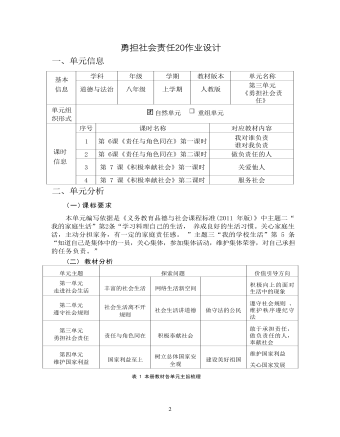
道德与法治八年级上册勇担社会责任20作业设计
本单元内容选至是八年级上册教材第三单元,在全书内容结构上起着承上启 下的作用。在了解社会生活和社会规则的基础上,本单元将进一步引导学生明确 社会责任,积极主动服务奉献社会。本单元是对第一单元、第二单元内容的深化。 本单元以“社会责任”为主题,基于学生可感知的社会生活,重点强调责任意识 和奉献精神的培养,使学生懂得因社会角色的差异而产生不同的责任,明确自身 应承担的社会责任,理解责任的承担和履行对个人、对社会的意义,培养学生的 责任意识。因此整个单元的核心任务是帮助学生认识到个人是社会的成员,社会 是由每个个体组成的。只有每个人承担责任,社会才能和谐发展;只有社会发展 了,才能为个人的成长提供良好的基础和条件。帮助学生理解承担责任的结果可 能会获得回报,也可能要付出一定的代价,懂得对自己的行为负责,使学生理性 对待承担责任过程中的得与失。引导学生感悟生活中无时无处不在的关爱,理解 关爱他人是一种幸福,同时也要讲究一定的艺术。引导学生思考服务和奉献的意 义,培养学生的服务意识和奉献精神。
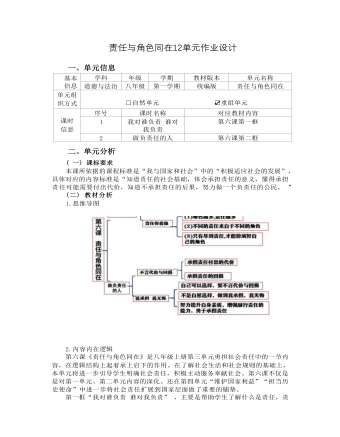
道德与法治八年级上册勇担社会责任12作业设计
(四) 作业分析与设计意图这是一项基于素质教育导向的活动式课时作业设计,以培育学生健全人格为 目标。作业以志愿者活动为作业形式,让学生以负责任为主题积极参与到对社会 负责的志愿者活动中去,并且通过参与志愿者活动,真正感受社会,提升社会责 任感,也让他们真正理解责任的意义,健全人格,提升道德修养,在以后的生活 中,可以更积极地帮助他人,为社会为国家做出自己应有的贡献。六、单元质量检测( 一) 单元质量内容1.“熊孩子”在电梯里小便,妈妈让孩子写了一份检讨,发到业主群里给大伙 道歉,每天由孩子的父亲监督孩子打扫电梯一个月。妈妈意在教育“熊孩子”要( )①明是非,懂规矩 ②有教养,尊他人 ③敢担当,勇负责 ④享权利,尽义 务A.①③④ B.①②③ C.①②④ D.②③④2.教师以教书育人为己任,快递员以顾客满意为追求,消防员以救人灭火为 目标,警察以维护秩序、护人安危为使命……社会的发展离不开每一个人的努力。这表明 ( )A.社会和谐稳定需要每个人承的担相应的责任
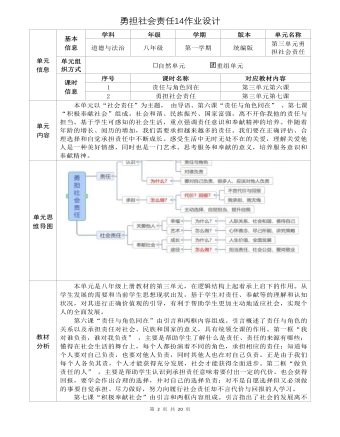
道德与法治八年级上册勇担社会责任14作业设计
本单元是八年级上册教材的第三单元,在逻辑结构上起着承上启下的作用。从 学生发展的需要和当前学生思想现状出发,基于学生对责任、奉献等的理解和认知 状况,对其进行正确价值观的引导,有利于帮助学生更加主动地适应社会,实现个 人的全面发展。第六课“责任与角色同在”由引言和两框内容组成。引言概述了责任与角色的 关系以及承担责任对社会、民族和国家的意义,具有统领全课的作用。第一框“我 对谁负责,谁对我负责” ,主要是帮助学生了解什么是责任、责任的来源有哪些; 懂得在社会生活的舞台上,每个人都扮演着不同的角色,承担相应的责任;知道每 个人要对自己负责,也要对他人负责,同时其他人也在对自己负责。正是由于我们 每个人各负其责,个人才能获得充分发展,社会才能获得全面进步。第二框“做负 责任的人” ,主要是帮助学生认识到承担责任意味着要付出一定的代价,也会获得 回报,要学会作出合理的选择,并对自己的选择负责;对不是自愿选择但又必须做 的事要自觉承担、尽力做好,努力向履行社会责任却不言代价与回报的人学习。















